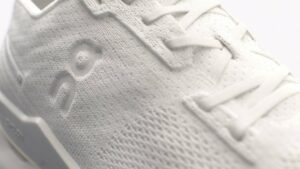Circular running … On, the Swiss sportswear brand, has created a fully recyclable running shoe made from castor beans, that you can regenerate every 6 months
January 23, 2023

The global economy is only 7.2% circular, according to the new Circularity Gap Report 2023 just published by Deloitte. And it’s getting worse year on year, driven by rising material extraction and use.
With a circular economy, we could fulfil people’s needs with just 70% of the materials we currently use, and therefore within the safe limits of the planet, the report suggests. Indeed circular solutions that address four priority areas – nutrition, housing, mobility and manufacturing – would address the majority of environmental pressures.
On, the Swiss sportswear brand, is a great example of how we could do better.
“Cyclon” is On’s groundbreaking circularity program. On’s Cloudneo is a fully recyclable running shoe made from castor beans. Lightweight, agile and super responsive, it’s engineered to perform. And you’ll never own it, because it’s only available via subscription.
Today, most products are designed within a linear lifecycle. That means one straight line to the trash. “Make-Use-Dispose.” When apparel and footwear have a predetermined destiny to become waste, that results in harmful effects on our planet. But we think there’s a better way. It’s called circularity.
How do you engineer a shoe from castor beans? It might seem like magic, but really it’s just science. A two-time ISPO award recipient, the Cyclon running shoe will feature a 100% bio-based upper. Made from just a single cut of fabric, so there’s zero waste and zero dyeing. Just pure material and pure performance.
Once you’re part of the Cyclon subscription, On sends your first pair of recyclable running shoes to you. After six months, you might be feeling the need to replace your well-worn and loved shoes. Not a problem. Hop back online and let On know to send a new pair to you. If your shoes haven’t gone the distance yet, you can replace them later.
The Circularity Gap Report 2023 explores how each country has a different starting point and will progress at a different pace towards the shared global goal of reversing environmental overshoot, while fulfilling people’s needs. Bringing these circular solutions to life requires an understanding of local, national and trading contexts.
To reverse the overshoot and achieve wellbeing within safe limits, purpose-driven collaboration between the public and private sectors is essential—only then can we scale the transition to a circular economy.
A circular economy offers solutions on how to reduce, regenerate and redistribute vital materials use, for both the planet and all its living beings.
The following three principles can help bring a shared focus to business leaders and policy makers:
- Reduce: from efficiency to sufficiency, resilience and adaptiveness … A circular economy must push for a cultural shift to prioritise immaterial ways to fulfil needs, and invest in health, wellbeing and education and decent jobs, rather than material accumulation—as does the predominant economic model in many parts of the world.
- Regenerate: from extraction to regeneration … The regenerative capacity of the planet is a gift—so we must respect and support its capacity to regenerate, also for future generations. Many regenerative solutions already exist today that show that we can move from humanity being net-negative to net-positive on Earth’s life support system.
- Redistribute: from accumulation to distribution … There is currently enough wealth and materials in the world to provide a good quality of life to every single human being on this planet
More from the blog